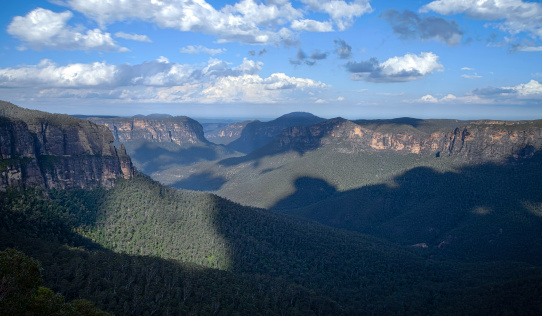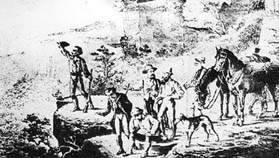Blaxland, Lawson and Wentworth were explorers.
They explored Australia when white people didn't know what was there.
They were the first white people to cross the Blue Mountains.
They did it in 1813.
kidcyber acknowledges the Australian Aboriginal and Torres Strait Islander peoples as the first inhabitants of the nation and the traditional custodians of the lands where we live, learn and work.
By 1813 the first settlement in Australia at Botany Bay had become crowded and more land was needed for the growing population.
From 1788 to 1813 the settlement at Sydney grew rapidly, and soon more land was needed to grow food and graze animals. The Blue Mountains, with their deep valleys and sheer cliff walls, was the barrier to expansion. Of course, the indigenous Australians of the area had many ways of crossing the mountains and had done so for thousands of years, but for white settlers the mountains were a barrier, and they could only guess what might be on the other side.
Image from Wikipedia
First published in The Sydney Mail newspaper 1880
Gregory Blaxland (1778 - 1853)
Wikipedia Commons image
Blaxland was born 17 June, 1778 in Kent, England. He sailed for Australia on 1 September, 1805 with his wife, three children, two servants, an overseer, a few sheep, seed, tools, groceries and clothing. When he reached Sydney he sold many of these items and made a profit which enabled him to buy eighty head of cattle so that he could breed cattle and sell the meat. He located 1,600 hectares of land that the government had promised to new settlers as well as forty convict servants and established his farm. He was also one of the first people to plant grapes in Australia and make wine, for which he was awarded a silver medal and later a gold one from the Royal Society of Arts in London. The town of Blaxland in the Blue Mountains is named for him.
William Lawson (1774 - 1850)
Unknown source
Lawson was born in England where he trained to become a surveyor. He migrated to Sydney arriving in 1800. He was an officer in the New South Wales Corp (army) and owned land where he raised cattle and sheep. He was invited to join the 1813 expedition by Blaxland
The town of Lawson in the Blue mountains is named for him.
William Charles Wentworth (1793? - 1872)
Wikipedia image
Wentworth was born in Australia to Irish parents. In 1802 he was sent to school in England and returned to Sydney in 1810, where he worked for the governor, Lachlan Macquarie, and was given a land grant of 710 hectares on the Nepean River.
The town of Wentworth Falls in the Blue Mountains is named for him.
The expedition across the Blue Mountains
These men were given permission by Governor Lachlan Macquarie to conduct an expedition to find a way across the mountains to new pastures for sheep grazing. They set off from Blaxland's (the leader of the expedition) farm on May 11, 1813, with four pack horses, five dogs, and four other people, three of them convicts. Their supplies for a six-week journey included salted meat, tents, compasses, cutting tools and guns.
After leaving from Emu Plains the explorers at first spent their time travelling along the main ridge that led them up into the mountains. They marked a track as they went, cutting bark from trees on either side so that they could find their way back again.
The explorers went down into a deep valley near Mount York to let their horses eat some fresh grass and drink water and later they crossed the valley and climbed a high hill on the other side. From here they saw some good grazing land to the west of the Blue Mountains. They returned on June 6 and much later their route became a highway.
Although they had crossed the Blue Mountains, the explorers had not crossed the Great Dividing Range. It was six months later that George Evans led a team, which followed the route taken by Blaxland, Lawson and Wentworth, and continued on over the Great Dividing Range. Evans and his team became the first Europeans to reach the rich grazing land in the area near Bathurst.
It’s a good idea to get your information from more than one source!
Read more about these explorers:
http://gutenberg.net.au/pages/blaxland.html
Read about why crossing the Blue Mountains was so important and what happened afterwards:
The Blue Mountains, Australia. Getty Images







